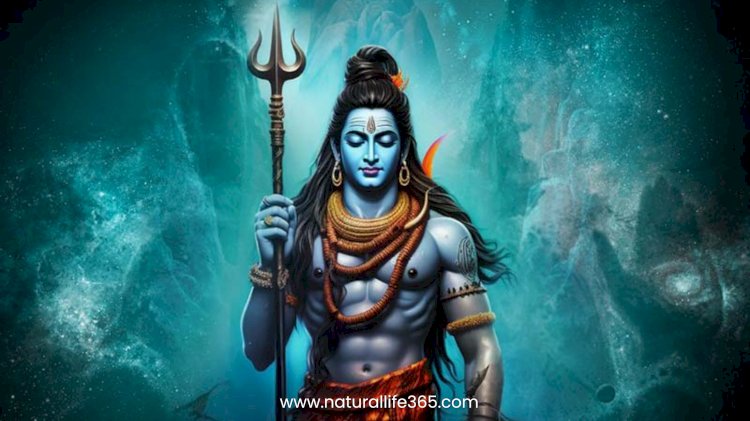Lord Shiva: The God of Destruction Explained
Gain a deeper understanding of Lord Shiva's role as the destroyer in Hindu mythology and its spiritual significance.

In the vast and intricate tapestry of Hindu mythology, few deities are as compelling and enigmatic as Lord Shiva. Revered as the God of Destruction, Shiva occupies a unique and pivotal place in the Hindu pantheon. Unlike the Western notion of destruction as purely negative, Shiva's role transcends mere annihilation. He embodies the cyclical nature of existence, where destruction is an essential precursor to rebirth and renewal.
Lord Shiva's iconography and attributes are rich with symbolism, each element contributing to a deeper understanding of his divine purpose. His serene yet formidable presence, adorned with a crescent moon, a serpent around his neck, and the sacred river Ganga flowing from his matted hair, presents a complex image that captivates and intrigues devotees and scholars alike.
This blog delves into the multifaceted persona of Lord Shiva, exploring his symbolism, myths, and philosophical significance. By unraveling the layers of meaning behind his title as the God of Destruction, we aim to illuminate the profound wisdom embedded in his worship and the timeless relevance of his divine attributes. Join me on this journey to discover why Shiva, the destroyer, is also revered as the ultimate source of creation and transformation.
Who is Lord Shiva?
Lord Shiva, one of the principal deities in Hinduism, is a figure of immense significance and profound complexity. Known as the God of Destruction, Shiva's role is not solely about ending but also about paving the way for new beginnings. He is a central figure in the Trimurti, the trinity of gods that includes Brahma, the Creator, and Vishnu, the Preserver. Together, they represent the cyclic nature of the universe—creation, preservation, and destruction.
Appearance and Symbols
Shiva's appearance is rich with symbolism, each aspect representing different facets of his divine persona:
- Trident (Trishula): Symbolizes the three fundamental aspects of existence—creation, maintenance, and destruction.
- Third Eye: Located on his forehead, it signifies his ability to see beyond the obvious, representing wisdom and insight. When opened, it can annihilate evil and ignorance.
- Crescent Moon: Worn in his matted hair, it represents the cyclical nature of time and his control over it.
- River Ganga: Flowing from his hair, it symbolizes purity and the life-giving force.
- Serpent (Naga): Coiled around his neck, it represents his mastery over ego and primal fears.
- Ash-Smeared Body: Represents the transcendence of physical limitations and the impermanence of the material world.
Does Shiva Have a Family?
Yes! Shiva’s family plays a significant role in his mythology and worship:
- Parvati: Shiva's consort, the goddess of love, fertility, and devotion. She embodies the feminine energy (Shakti) and complements Shiva’s destructive aspect with her nurturing presence.
- Ganesha: The elephant-headed god of wisdom and remover of obstacles, is the son of Shiva and Parvati. Ganesha’s blessings are invoked before embarking on any new venture.
- Kartikeya: Another son of Shiva and Parvati, Kartikeya is the god of war and victory. He is revered for his martial prowess and leadership.
- Nandi: Shiva’s loyal mount, the bull, symbolizes strength and righteousness. Nandi is also considered a gatekeeper and a close devotee of Shiva.
Shiva’s Abode: Mount Kailash
Shiva resides atop Mount Kailash, a sacred peak in the Himalayas. This celestial abode is not just a physical location but a symbolic representation of spiritual enlightenment and detachment from worldly desires. Mount Kailash is regarded as the center of the universe in Hindu, Buddhist, Jain, and Bon traditions, making it a pilgrimage site for devotees from various faiths.
Lord Shiva's portrayal as a divine ascetic, meditating in the serene heights of Mount Kailash, highlights his detachment from materialism and his pursuit of inner peace and higher consciousness. His life and attributes serve as a guide for devotees striving to transcend the mundane and achieve spiritual awakening.
The Role of Shiva in Hindu Mythology
Lord Shiva holds a crucial and multifaceted role in Hindu mythology, serving as the God of Destruction within the Hindu Trinity, or Trimurti. This divine trio consists of Brahma the Creator, Vishnu the Preserver, and Shiva the Destroyer. While destruction might seem negative at first glance, Shiva’s role is deeply rooted in the concept of cosmic balance and renewal.
The Trinity: Brahma, Vishnu, and Shiva
The Trimurti symbolizes the cyclical nature of the universe, with each god representing a fundamental aspect of existence:
- Brahma: The Creator, responsible for the creation of the universe and all living beings.
- Vishnu: The Preserver, who maintains order and harmony in the universe.
- Shiva: The Destroyer, who brings destruction not as an end, but as a means to enable transformation and regeneration.
Shiva’s destructive power is essential for the process of creation and preservation. Without destruction, there can be no renewal, no rebirth. His role ensures the removal of impurities and the old, making way for the new.
The Concept of Destruction as Creation
In Hindu philosophy, destruction is not viewed as an end but as a necessary step for new beginnings. Shiva’s destruction is a form of purification, cleansing the universe of its accumulated negativity and making way for positive transformation. This cycle of destruction and creation is mirrored in natural processes, such as the changing seasons, the life cycle of plants, and the birth-death-rebirth continuum in living beings.
Shiva's Role in the Cosmic Cycle
Shiva’s dance, known as the ‘Tandava’, epitomizes his role in the cosmic cycle. This dance, often depicted in the form of ‘Nataraja’ (the Lord of Dance), represents the dynamic flow of the universe. The Tandava has both a fierce, destructive aspect and a gentle, creative aspect, symbolizing the continuous process of creation, preservation, and destruction.
In the Tandava, Shiva’s right foot, raised, signifies liberation and spiritual upliftment, while his left foot, which treads on the demon Apasmara (symbolizing ignorance), signifies the destruction of ignorance. The flames encircling Shiva represent the cosmic fire that purifies and renews.
Mythological Stories Highlighting Shiva’s Role
Several myths underscore Shiva’s role as the destroyer and transformer:
- The Churning of the Ocean (Samudra Manthan): During the churning of the ocean by gods and demons to obtain the elixir of immortality, a deadly poison, Halahala, emerged. Shiva consumed the poison to save the universe, earning the name ‘Neelkanth’ (the blue-throated one) due to the poison staining his throat blue. This act highlights his role in absorbing negativity and protecting the cosmos.
- The Destruction of Tripura (Tripurantaka): Shiva destroyed the three cities of the demons (Tripura) with a single arrow, symbolizing the destruction of evil and the restoration of cosmic order.
- The Dance of Destruction (Tandava): When Shiva performs the Tandava, he brings about the end of an era, leading to the dissolution and subsequent renewal of the universe.
Through these stories and his symbolic dance, Shiva’s role as the God of Destruction is shown to be vital for maintaining the balance and continuous evolution of the universe. His power of destruction is not to be feared but understood as an essential part of the eternal cycle of creation, preservation, and renewal.
Shiva's role in Hindu mythology transcends the mere act of destruction. He embodies the profound truth that in every end lies the seed of a new beginning, emphasizing the transformative power inherent in the cycle of life.
Philosophical Interpretations of Shiva
Lord Shiva, revered as the God of Destruction, embodies a complex and profound philosophical significance in Hinduism. Beyond his mythological narratives and symbolic attributes, Shiva represents various dimensions of spiritual insight and metaphysical concepts that different schools of Hindu have interpreted thought. Understanding these philosophical interpretations can offer deeper insight into his divine nature and the timeless wisdom he imparts.
Shiva in Different Schools of Hindu Philosophy
1. Shaivism:
- Shaivism is the branch of Hinduism that worships Shiva as the Supreme Being. In this tradition, Shiva is seen as both immanent and transcendent, embodying the totality of existence.
- Panchakshara Mantra ("Namah Shivaya"): This sacred five-syllable mantra is central to Shaivite worship, symbolizing the essential aspects of Shiva’s nature.
- Shaiva Siddhanta: This philosophy views the soul’s liberation (moksha) as a union with Shiva, achievable through rituals, devotion, and yogic practices.
2. Vedanta:
- In Advaita Vedanta, Shiva is often equated with Brahman, the ultimate, formless reality that pervades the universe. Shiva symbolizes the non-dual nature of existence, where the individual self (Atman) and the universal self (Brahman) are one.
- Dvaita Vedanta: In this dualistic school, Shiva is viewed as a personal god, separate from the individual soul, who can grant grace and liberation.
3. Tantra:
- In Tantric traditions, Shiva represents pure consciousness (Shiva) and dynamic energy (Shakti). The union of Shiva and Shakti symbolizes the merging of consciousness and energy, leading to spiritual awakening.
- Kundalini Yoga: Shiva is seen as the dormant energy residing at the base of the spine, which can be awakened through spiritual practices to achieve higher states of consciousness.
Shiva is a Symbol of the Inner Self and Consciousness
- Inner Transformation: Shiva’s role as the destroyer can be seen as a metaphor for inner transformation. By destroying ignorance, ego, and attachments, Shiva facilitates the soul’s journey towards enlightenment.
- Meditation and Asceticism: Shiva is often depicted in deep meditation, symbolizing the importance of introspection, mindfulness, and ascetic practices in attaining spiritual growth. His ascetic lifestyle underscores the value of renunciation and self-discipline.
The Significance of Meditation and Asceticism
- Path to Enlightenment: Shiva’s meditative state represents the ideal of achieving inner stillness and enlightenment. His detachment from material pleasures emphasizes the pursuit of higher spiritual goals.
- Role Model for Yogis: Shiva is considered the Adiyogi (the first yogi) and the ultimate guru. His teachings on yoga, meditation, and asceticism are foundational for practitioners seeking to transcend the physical world's limitations.
Shiva’s Philosophical Impact on Hindu Thought
- Cycle of Creation and Destruction: Philosophically, Shiva’s role in the cosmic cycle of creation, preservation, and destruction illustrates the impermanence of the material world and the eternal nature of the soul.
- Duality and Non-duality: Shiva embodies the paradox of duality and non-duality. He is both the formless absolute and the manifested world, illustrating the unity of opposites and the oneness of all existence.
As you can see, Lord Shiva, the enigmatic and powerful God of Destruction, holds a central and transformative role in Hindu mythology and philosophy. His divine persona encompasses a rich tapestry of symbolism, mythological narratives, and profound spiritual teachings. By understanding Shiva's attributes, stories, and philosophical interpretations, we gain insight into the essential truths of existence—where destruction is not an end but a necessary precursor to renewal and creation.
I invite you to delve deeper into the fascinating world of Lord Shiva. Share your thoughts and interpretations in the comments below. How has Shiva's symbolism or stories influenced your spiritual journey?
If you found this blog enlightening, share it with others who might appreciate the profound wisdom of Lord Shiva. Join our community for more explorations into the rich tapestry of Hindu mythology and spirituality.
Stay connected for more insights and discussions on the divine and the mystical.
Namaste!
If you value these free online resources provided by Natural Life 365, please consider supporting my website by sharing the blogs ![]()








































